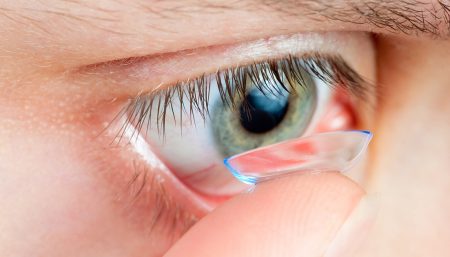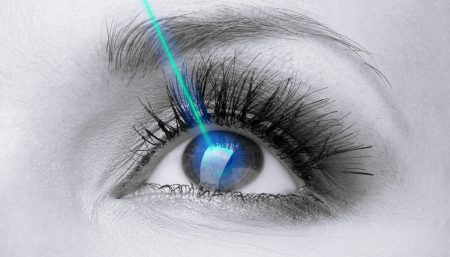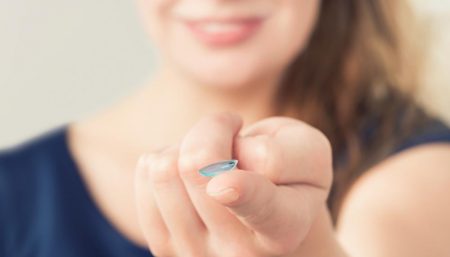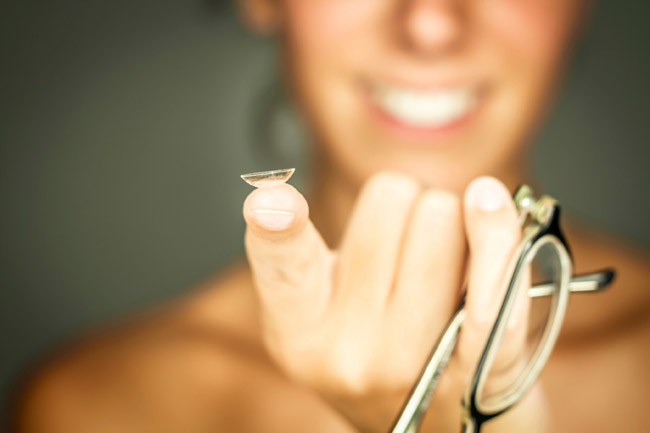
With an eye-boggling choice of contact lenses on the market, most of us can now afford to flying away glasses and invite ‘passes’ from the opposite sex.
Besides adding to your eye appeal, contacts also offer other benefits over spectacles such as:
- No blind spots. You can see to the extreme right or left without having to swivel your head.
- Less distortion.
- No more spectacles that slip over your nose, irritate your ears, steam over.
- More activity to your lifestyle.
- Less changes in your number.
Not everyone can wear contact lenses. Some women’s eyes simply cannot tolerate them-particularly lenses that are hard because their eye tissue is too sensitive. Others have a medical condition which prevents them from wearing lenses with and ease. This includes women with allergies, sties or other disorders, such as excessive watering or bloodshot eyes. People with arthritis or tremors will have difficulty inserting the lenses, which require some manual dexterity.
Contacts also require more care than specs. They are easier to lose and damage. And, they take a bit of getting used to.
Possible complications from contacts include corneal abrasions, swelling and infection. Symptoms like pain, redness and tearing may occur if contacts are damaged, improperly cleaned, worn out or worn too long, Or poorly fitted.
You need a qualified contact lens specialists to guide you about what type of contact lens is best suited to you depending on the health of your eyes, type and amount of vision correction, lifestyle and budget.
For a perfect fit, you need a comprehensive eye examination and specific measurements-absolutely essential because contact lenses are in direct contact with soft delicate eye tissue which can be easily damaged.
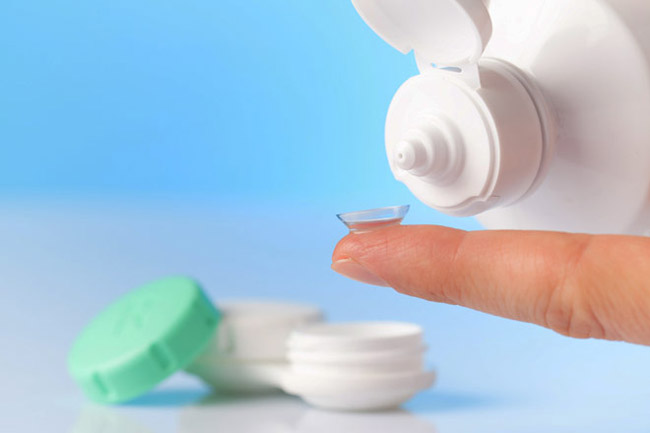
There are two general categories:
RIGID LENSES
Rigid lenses covers a portion of the cornea and maintain their shape when placed in the eye. Here we have hard and semi-hard lenses.
SOFT LENSES
Soft lenses covers the entire cornea and are made of flexible, water-absorbing material which fits into the curve of the eye. These come in reusable and disposable varieties, daily and extended wear, and colored.
HARD LENSES
Hard Lenses made of a plastic polymer are the oldest, cheapest (between Rs. 600 to Rs. 800 a pair), and most durable as they last for 3 to 5 years and provide the sharpest vision. They are also easy to clean, require less maintenance and are less prone to infection. However, they feel like a foreign body in the eye, and make sensitive eyes look bloodshot. It takes 2 to 4 weeks of gradually lengthened periods of wear to break them in. Often, you must wear them daily, but not more than 8 hours. They also dislodge easily, may cause glare and dust to get caught behind them.
SEMI-HARD LENSES
Semi-hard lenses are made out of gas permeable polymer which allows oxygen and other gases to pass through to the cornea. They are an improvement over hard lenses as they can be worn longer, are easier to adjust to, and less irritating to the eye. They cost between Rs. 1000 to Rs. 1200 a pair and last for 3 years. However, although they require less maintenance then soft lenses, you must care for them each time you put them on and take them out, and soak them overnight.
Semi-hard lenses are not suitable for sportsmen because they attract dust.
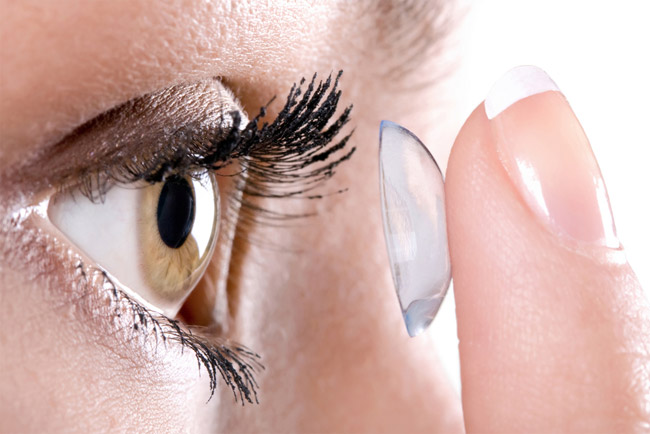
SOFT LENSES
They are most comfortable as there is no foreign body sensation. Your eyes adjust to them in a week, they cause less glare, are less apt to dislodge, can be worn for longer periods of time, and are easier to alternate with glasses. But they cost more (Rs. 1200 to Rs. 1800) and require scrupulous hand hygiene, special cleaning and a weekly enzyme treatment. You must follow this regime as faithfully as you brush you teeth.
Soft lenses last for only 1 to 2 years and are likely to tear and deteriorate from contact with smoke, vapors, sprays and cosmetics. With soft lenses, your vision may not be as sharp, so you can’t use them if you suffer from astigmatism (which results from a misshapen eyeball, cornea or lens). Your eyes are also more prone to infection and keratitis (swollen cornea) specially if you forget to remove them and fall asleep.
DISPOSABLE LENSES
These lenses are taken out every night and can be discarded daily (Dailiees), one to two weeks (Acuvue), one month (Vistavue, Focus), after which you use a fresh pair. They cost from Rs. 4000 to Rs. 6000 for a year’s supply.
They are easy to care for as they require minimum nightly cleaning and eliminate long term dirt build-up. So you get the constant comfort of new lenses and are extremely convenient. You can’t wear them if you are subjected to too much dirt.
COLORED
Yes, you can now change the colour of your eyes. There are five basic colours-brown, blue, grey, green and violets, with a wide palette of variations. These soft lenses come with or without power. CIBA`s
Illusions are Rs. 4000 plain and Rs. 5000 powered. Foreign brands are sold in India at Rs. 6500 to 7000 and Rs, 2500 to Rs. 3000 (disposable). They last for one-and-a-half to two years. You care for them like soft lenses, but there is no enzyme treatment as this tends to discolor them.
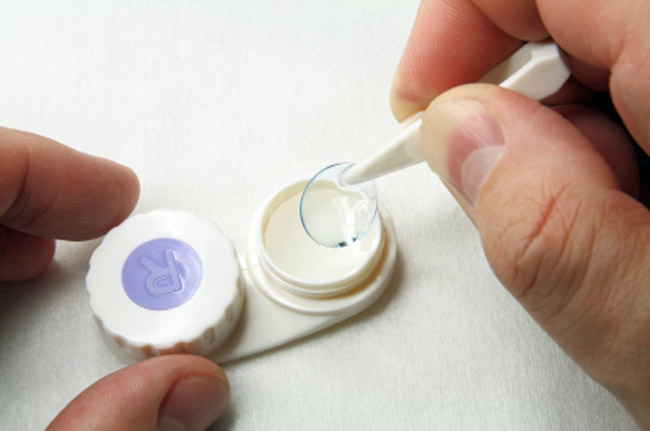
Each type of contact lens has its own special solution to keep it immaculate by way cleaning, disinfecting, soaking. It is extremely important to use the correct product and to follow the instructions on the packages and from your practitioner. Failure to follow instructions may shorten the life of your lenses and can even lead to infections of the cornea and tissue surrounding the eye.
- Wash you hands before touching your lenses or your eyes with a mild soap (without perfume, deodorant or cream which may cause allergy). Do not touch them with your finger nails.
- Store your lenses in a proper container and always in the same place.
- Do not swim with lenses in you eyes as the chlorine cam damage them.
- Apply cosmetics after inserting lenses and remove lenses before removing make up.
- Use water-based eye make up and cleansers and choose from products marketed ‘hypoallergic’.
- Keep eye glasses with a current prescription in case of lost lenses or an eye problem.
- Periodic eye examinations are also necessary to be sure that visuals needs are not changed and to allow the doctor to monitor the health of your eyes.
- See your contact lens specialist or ophthalmologist at the first sign of eye infection-redness, discomfort, swelling or unusual discharge-and stop using your lenses.
If your lens has slipped, look to the direction of the displaced lens. It should automatically move towards the centre of the eye and take the correct positive. Or close your eyelids and gently massage the lenses into place through the closed lid, using your index finger. Gently push the off-centered lens onto the cornea while the eye is open, using finger pressure on the edge of the upper lower lid.
If it has dropped into a wash basin, close the drain while you look for it. If it’s on the floor, warn others to stay away and search the floor inch by inch. It may help to darken the room and beam a torch over the area. The lens should gleam in the light.
If it’s a soft lens and you don’t have your case handy, drop it in a glass of water. Sterilize before reinserting.
Disclaimer
The Content is not intended to be a substitute for professional medical advice, diagnosis, or treatment. Always seek the advice of your physician or other qualified health provider with any questions you may have regarding a medical condition.

